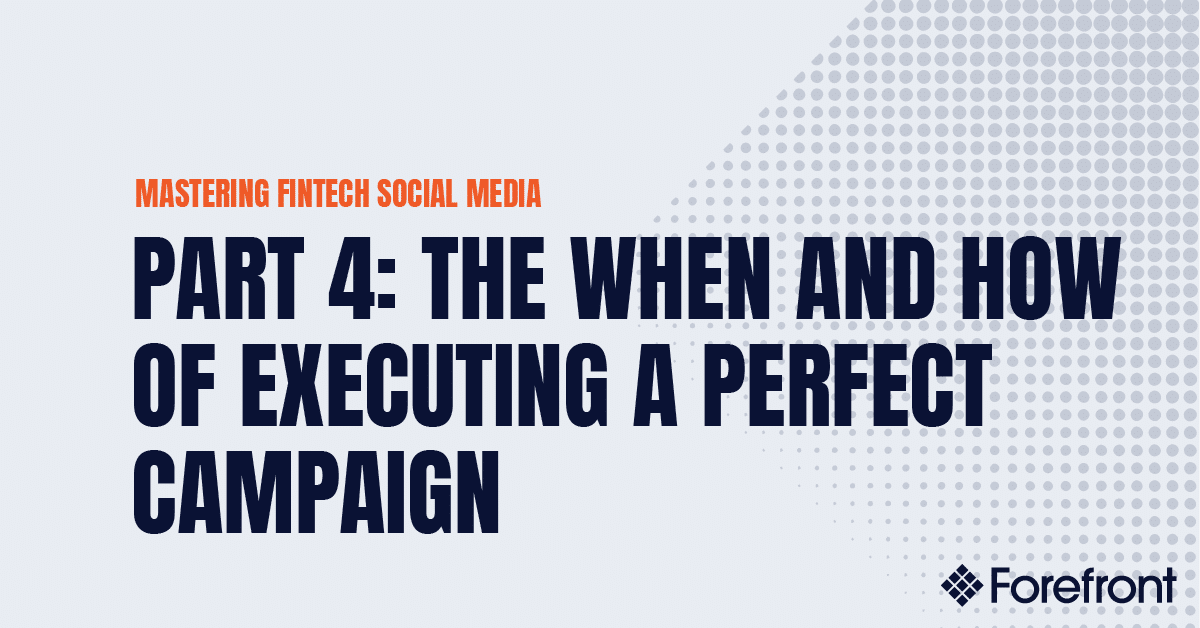This is the fourth blog post in our five-part series about mastering fintech social media. To read the first three blog posts in this series, click here.
So you’ve come up with a list of key messages, designed compelling graphics to accompany them and optimized everything for the appropriate platforms. Now it’s time for the rubber to meet the road and to execute your social media marketing campaign and share your social campaign with the wider world.
This is easier said than done. Like every other step in the process, there are a number of best practices involved in going public with a polished campaign, and getting smart on them can make the difference between big numbers and bitter disappointment.
Successful Social Media Campaigns
For starters, the number of times you post can be almost as important as the content marketing itself. Just like you wouldn’t take the time to meticulously prepare for a job interview only to annoy the hiring manager with incessant follow-up emails, it doesn’t make sense to do the legwork to craft a successful campaign and then proceed to annoy your followers by spamming it to people’s feeds.
On the other hand, you don’t want to miss a chance to capitalize on that legwork by posting too infrequently and potentially missing large parts of your audience. It’s a balancing act.
And like so many other aspects of social media strategy, the right frequency depends on the exact platform you’re using.
Here are some guidelines for Twitter and LinkedIn:
Social Media Channels
Twitter – In an analysis of over 11,000 tweets from leading global brands, social media marketing firm Socialbakers found that total engagement grows only slightly beyond the third tweet in a given day. Another analysis from social analytics company Track Social found that accounts that tweeted four to five times a day saw the highest retweet rate.
Therefore, the sweet spot for Twitter is three to five tweets a day. You can certainly tweet more – some especially active accounts tweet as many as 30 times a day – but you run the risk of annoying people, being redundant and spending too much time on it, especially as a small business.
LinkedIn – In a report released a couple of years back, LinkedIn revealed that users should seek to post 20 times a month, or about once a business day. This allows you to reach as large a subset of your audience as possible without overdoing it. As the LinkedIn audience is typically less active than that of Twitter and posts have a longer shelf life, posting too often can be a bad look and the algorithm will ding you for it.
The timing of your social media marketing campaign is also crucial to its success. Your content may look the same no matter when it is posted, but when it comes to an audience made up of people with busy lives, you need to take their schedules into account. Timing your campaign to reach as many of them as possible will almost always be more successful than posting at any old time and hoping for the best.
Obviously, a post that goes out at the start of a workday and one sent in the middle of the night are going to perform differently, but what are the specific best practices around when to post to Twitter and LinkedIn? Here are some guidelines:
Twitter – According to Hootsuite, B2B brands should try to post between 9 am and 4 pm EST, with a particular focus on the 11 am – 1 pm window. Monday and Thursday are the best days of the week to post, but any weekday is fine. For B2C brands, zeroing in on people’s lunch breaks is more important, so the 12 pm – 1 pm window is your best bet.
LinkedIn – Hootsuite lists four optimal times for posting to LinkedIn: 7:45 am, 10:45 am, 12:45 pm and 5:45 pm EST. Monday through Thursday get similar results, but there is a slight decline on Friday followed by a steep drop off over the weekend.
Digital Campaign
A few other best practices to keep in mind:
- These days, most social media platforms offer the capability to schedule posts in advance. Take advantage of this feature and you’ll never have an excuse for not posting at an optimal time again.
- Always be sure to tag any other firms or individuals you mention in your posts. Beyond being good social media etiquette, this increases your reach and invites the tagged account to share your post.
- Use hashtags – but be smart about it. A broad, unfocused hashtag means your post will probably be drowned out by the thousands of others, while one that is too specific simply won’t serve a purpose. Try to find hashtags that are focused enough for you to stand out but popular enough that they will reach people who aren’t connected with you. And please, do not finish off every post with a laundry list of hashtags – they won’t make much of a difference and your followers will roll their eyes.
These best practices will serve you well on your social media journey, but some of these rules may be different when it comes to paid social campaigns. Keep an eye out for our next post for more on that. Until then, check us out on Twitter (@ForefrontComms) and LinkedIn to see these principles in action, and feel free to reach out to me at sbelden@forefrontcomms.com with any questions.
